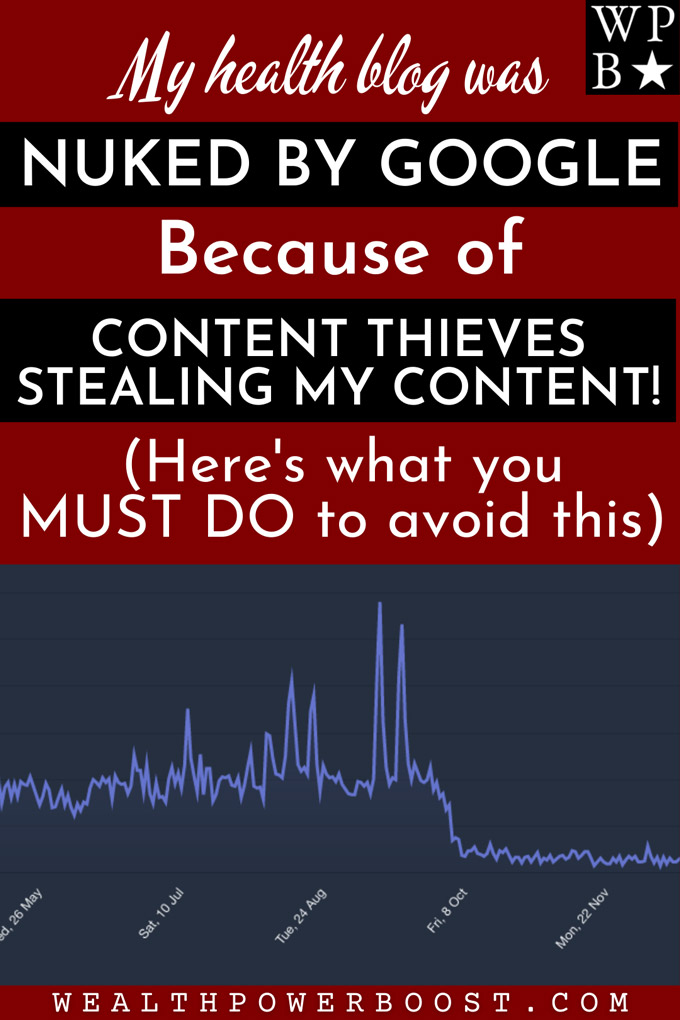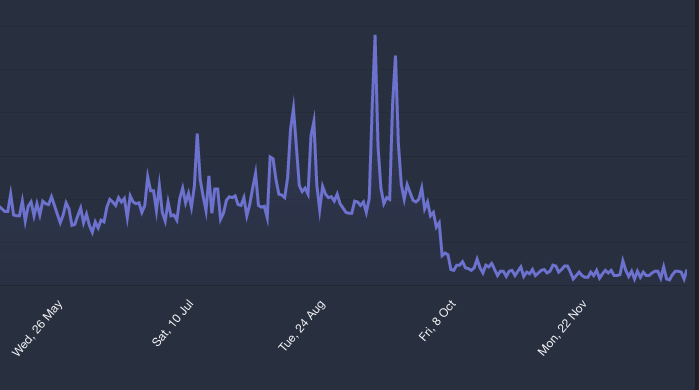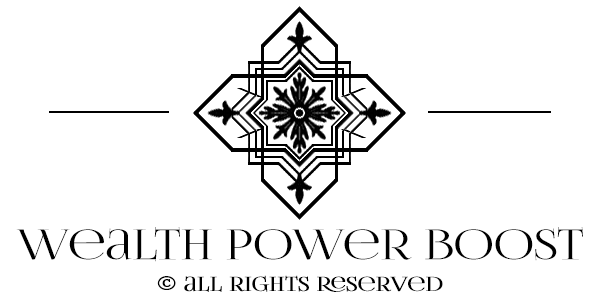This website is not financial advice. Posts may contain affiliate links from which I earn commissions at no additional cost to you.

Graphic © WealthPowerBoost.
If you’ve ever seen your Google traffic do something like this (or even a complete flatliner) you’ll know what a “Google Slap” looks like…

Ouch! Hey now, what did I do wrong? As it turns out… nothing at all… sheesh…
My ace is social media traffic. Technical SEO, not so much. Truth be told, I have crushed it so hard with social media traffic that I was like “Who even cares about SEO??” But I needed to fix this – because even though the big G is not my #1 traffic source, or even #2, Google traffic is good traffic – and we all need that.
So I had a consultation with a serious SEO expert and his team did a deep dive on my site, using ahrefs (SEO technical audit tool) to see what the problem might be…
The site in question was a natural health blog that got massive and I mean massive social media traffic and engagement back in the day. It had over 4 million Facebook fans; days where the number of pageviews from Facebook went over 300,000 (yes in one DAY!); and I had numerous posts with over 100,000 shares.
You won’t get that much traffic from Pinterest or Google. Facebook can send enough traffic to break your web hosting when you nail it!
It’s strange how too much success can sometimes bite you in the butt… most people will only learn this when it has actually happened to them and those few who have experienced such things are nodding in agreement right now.
The net result of the runaway “superviral” success of my health blog was that everyone stole our content and I mean everyone. Content thieves deliberately target the most viral stuff because they know it will get the most clicks.
When I say stole, I don’t just mean people sharing the post on FB….
Article thieves copy pasted the entire article onto their blog, or put the images on their own dodgy websites full of other stolen images. No permission asked of course.
Pinterest spammers stole my viral infographics, cropped out my logo and pinned my images, however instead of linking to me from Pinterest, they linked to their own crappy pages with zero content value. So they were literally stealing my traffic!
I filed a Pinterest DMCA on 500 (yes 500) of these stolen images in one shot. Then (coincidence? I think not) my site suddenly got banned from Pinterest a few days later – leading to the unbelievably whacked situation where the only copies of my images Pinterest would allow on their site were the stolen ones!!! Whether or not this was a) them making a stupid mistake and thinking my site was the one being reported b) someone making a revenge claim c) them reviewing my site and deciding they didn’t like it for some other reason, I will likely never know. Getting any sense out of their support? Good luck… it was like throwing coins into a canyon… you can’t hear them hit the bottom… I was not able to get my site reinstated.
And then Google………..
So my articles had “innerlinks” in them. It’s fairly normal – and used to be known as “pagerank sculpting”. In “wikipedia style”, you put a link from one of your articles to another one of your articles, in places where the “keyword” appears.
The article thieves then scraped my articles, however they did not even bother to strip the links out.
Now, why is this a problem? You ask.
Because I now have hundreds of links to my site from “bad neighborhood” .ru and .cz domains packed full of stolen content, all with the same link anchor text!
So Google’s stupid algorithm thought I was link spamming, and down I went!
I can’t be anywhere near the only person this is happening to. It’s so crazy when technology implemented to combat spammers has such obvious and visible unintended consequences. But that’s Google for you. They have these… ideas… that machines can replace humans. And they are going to reinforce those beliefs in every way they can!
And can you actually talk to anyone at the big G? Good luck with that, pal!
Fortunately there is a lot you can do.
How To Combat Theft Of Your Content (including “evil genius” tactics)
0) Get Your Own House In Order
Make absolutely sure there is no stolen content on your own sites. None of this is legal advice, of course. But I highly suggest to do this now and thank me later, because let me assure you, this war is only starting to get warmed up and it’s going to get serious.
Images – Get rid of any images that you are unclear about. You need either to have created the image yourself from scratch, or have the correct license, or written permission, or verified proof that the image is from a public domain (CC0) source. Keep records of everything and keep it organized! If you can’t remember where you got the image from, FFS delete it from your website asap! Find something you can confidently use instead. There are now legal teams filing “carpet bomb” legal cases against image thieves. Claims that it was “accidental” will not protect you from being hit with their expensive out-of-court settlement costs. Being a small non-profit site will not protect you. Claiming “fair use for educational purposes only” when you have ads or affiliate links on your pages will not protect you!
Text – You need two steps here. Step one – use Copyscape Pro (it’s awesome) to find copies of your content. Step two – use Google search. Grab at least two sentences at random from your article and put them in google search (i.e. 2 or more separate searches).
Why do you need both of these steps? If you hired cheap “five dollah” article writers, I got bad news for you… your site quite likely has stolen content on it. Quite a few of them literally cannot write a perfect sentence – but they know about Copyscape. A few of them even advertise that they can create articles that pass Copyscape!! But this word “create”… I do not think it means what they think it means… They cobble together articles by swiping a sentence from here, a sentence from there, and then swapping out some words until it passes Copyscape. It’s not good enough. It’s either unique content or it isn’t and you can bet Google’s analysis tools are top notch. Fire any “writers” (they are not really writers) that do this and fix your articles, rewriting all sections that contain a majority of copied words. What Copyscape doesn’t find, a Google search probably will – and then the fun begins, because you need to determine whether your writer stole it from them, or whether the other site stole it from you! Filtering by date in Google search settings might help.
1) Assume That Your Content Will Get Stolen – And Be Prepared To Take Action
The irony of internet success is that the more successful you are, the more your stuff will get stolen. It’s completely insane. It’s such a P.I.T.A. And when you are running 20+ websites, all with email lists, social media accounts etc, do you really need more stuff to have to deal with? But it’s a fact of life on the www, also known as the Wild West Web. For too long I just thought “I will invent faster than they can copy” but that eventually came around to bite me and so it’s better to stay on top of things.
2) Understand That Not All Links Are Good Links And That You Will Need To Monitor It
Putting a healthy sprinkle of links in your own articles to your blog’s other topically relevant posts helps your site’s rankings, but when your content is stolen, it becomes a problem. I mistakenly thought “well, if they steal my articles, at least I will get a link”. No. Not all links are good links. The bad ones hurt you. But you can fix it.
3) How To Locate Stolen Content
Locating stolen content is not that hard. Copy-paste a sentence or two from the article into Google and the majority of copies will show up. Reverse image search (drag and drop in google images) will pop up copies of your images. And just scrolling below your pins in Pinterest “more like this” will often show up your stolen content. Pinterest recommending your own stolen content for you to explore… oh the irony!
4) Filing DMCA Will Only Get You So Far…
Generally speaking, people in 1st world countries will honor DMCA requests and they typically take fast action, because legal problems are not what they need. However if your site was scraped by someone in a more rough-and-tumble country, shall we say, the chances are they DGAF – and even if there is contact info on their site, you probably won’t get very far. Ask me how I know!
5) Database And Disavow
Fortunately, you can disavow undesirable links from hurting your site in Google Webmaster Tools / Google Search Console. In order to combat Google Bowling – a nefarious practice where a competitor deliberately blasts their enemy’s site with spammy links in order to get it nuked from the rankings, Google gives the ability to disavow links. Once you have verified that you are the site owner (easy little hoop you have to jump through), you can notify them to ignore any links when analyzing your site’s link profile. You can also file DMCA via Google Webmaster Tools to clean up Google results! Nice!
So the first step is to get a thorough a list of these links as you can. Go to the awesome ahrefs (you can create a free account, although it’s a bit buried because they prefer people to start the trial – click “sign in” and then “sign up”) and then do a site audit on your site, to analyze all the links pointing at it. Load up your site in ahrefs and look at the backlinks. Go to anchors and look at the anchor text, which will reveal unusual patterns. Then look at links to target. Any links that have high traffic, you might want to hang on to. But anything which scrapes your content and has minimal or 0 traffic. Grab all those URLs, cos it’s time to nuke ’em! 🙂
Paste all those links into a database and review them to mark up A) which ones are either copies of your articles and B) which are any other type of dodgy “bad neighborhood” link you don’t want. For type A – go to Google Copyright Removal Dashboard. This will get the offending content de-indexed, but of course this is a legal form so you have to affirm in a sworn statement that you are the copyright owner. Boom! Fix your link profile and then hopefully within a few weeks / months, your Google rank ought to recover – if this was what caused the derank in the first place!
For type B – follow Google’s disavow tool instructions here. Yes, it’s a lot of work but worth it. And you can get one of your amazing VAs to help.
6) Playing Hardball
If you finally decide you are “****ing over it”, and you want to bring in the tanks, it turns out that you do have a Panzer division available to you 🙂 Bringing the big guns onto the field is becoming more prevalent now and I do think that image theft is going to become a thing of the past in the next few years because of the escalation of weaponry the plaintiff has at their disposal. 😉 Here are a couple of choice tactics for when you have finally snapped and decided on a scorched earth policy…
6a) Report them to their ISP / web host. So it turns out that you can file DMCA on an ISP / web host as well as the website owner. Nice!!!! More info here https://www.dmca.com/FAQ/What-is-a-DMCA-Takedown. This is a super tactic because while a spammy website owner might ignore your DMCA or be unreachable, a web host will 99.999% be reachable – and won’t want to risk DMCA. They would rather nuke the website concerned than get nuked themselves.
Unbelievably, there is even a service called “DMCA ignored hosting” now. In other words, web hosting that claims it will ignore DMCA requests on your behalf. Again not legal advice but this seems highly illegal. File the DMCA anyway.
6b) Hire the heavy hitters to go into battle for your stolen images. For example these guys. Picrights.com They work for major image libraries and other content creators to manage their copyright issues. They essentially threaten legal action and frighten image thieves into paying up – in return for a percentage of the settlements they get from terrified bloggers who stole your content. It’s kind of cruel to do this, in a way. But it works and they did steal your content after all – so it’s ultimately fair play.
6c) Get a lawyer. It’s likely only worth doing if the perpetrator is visibly making profit from unauthorized use of your content or harming your revenue significantly. Take screenshots of everything and keep good records.
7) Evil Genius Tactics 😈
7a) “Land mines”. To continue with the military metaphor – what does an army do when they want to make life hard for the enemy? They set traps. So, you know how some hashtags or even words are completely unique and #nobodyelseontheplanetwillprobablyusethatone. If you can drop a random character string into all your articles, somewhere, then it helps “watermark” them. You have a way to search the entire internet in one shot for scraped copies of your content. Something like this: 2@42&^%$gr Anyone doing a manual content swipe will of course strip out a nonsense word. But most of the scraper sites are doing this stuff with bots, so you can watermark your articles with something like that and it will give you an edge on finding this stuff more easily in the future / or when they “spin” your article. Another thing you can do is use Google Alerts as an early warning system.
7b) Oh, I just thought of another beauty. Now this one’s really fun. “Hotlinkers” will steal your image by copy pasting your image URL, so that your image displays on their website without them hosting the image. So they are stealing the image and draining your own hosting resources in order to do so. You can locate these hotlink images easily using ahrefs. Simply change the URL of the image on your own site and then replace the image at the original URL with a rickroll type image or something that says “image stolen”, or whatever prank image you want, really, within legal limits of course. Just make sure it’s only going to appear on their site, not yours. At some point they will notice, but until then, you can have some very justified fun at their expense.
8) Watch Out For Backlash
Note that you take revenge on scammers, spammers and thieves at your own risk. I do not say this lightly. Some of them will retaliate. You might face “revenge filing” / fake claims against you, or DDOS, etc. Make sure your own house is in order first and protect yourself against DDoS or other malicious attacks with for example Cloudflare and security measures as appropriate.
There are more things you can do, too. Found a great tutorial here: Content Copycat: What To Do When Your Website Gets Copied

